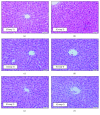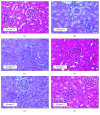Comparative Biochemical and Histopathological Studies on the Efficacy of Metformin and Virgin Olive Oil against Streptozotocin-Induced Diabetes in Sprague-Dawley Rats
- PMID: 30581871
- PMCID: PMC6276431
- DOI: 10.1155/2018/4692197
Comparative Biochemical and Histopathological Studies on the Efficacy of Metformin and Virgin Olive Oil against Streptozotocin-Induced Diabetes in Sprague-Dawley Rats
Abstract
Treatment of diabetic patients with antioxidant, such as extra virgin olive oil (EVOO), may be beneficial in numerous debilitating complexities. This study was aimed at assessing the protective role of virgin olive oil in reducing hyperglycemia in streptozotocin- (STZ-) induced diabetic rats. Thirty-six healthy male Sprague-Dawley rats were divided into six groups (6 rats per group) including nondiabetic control (NC), diabetic control (DC), and animals treated with metformin, olive oil, and a combination of olive oil and metformin, respectively. The protective effect of olive oil was evaluated by determining the biochemical parameters (lipid profile, liver, and kidney) and by studying the histopathological alterations in pancreas, liver, and kidney tissues. The results showed a significant increase in alanine aminotransferase (ALT) and alkaline phosphatase (ALP) levels in diabetic rats. ALP levels remained significantly elevated in the diabetic rats that were treated with metformin and/or olive oil, and the highest level was noted in the group treated with olive oil (568.33 U/L). Contrarily, pretreatment with olive oil significantly decreased ALT (67.64 U/L) and ALP (226.17 U/L) levels. Histopathological data revealed that all the disorganized islets of Langerhans along with the clusters of inflammatory cells were absent in the group pretreated with the combination of virgin olive oil and metformin, which shows that prophylactic administration of this combination reduces the diabetic complications in a much better way. Therefore, pretreatment with olive oil with or without metformin is an encouraging approach for diabetes therapy with immense potential.
Figures



References
-
- NCD Risk Factor Collaboration (NCD-RisC) Effects of diabetes definition on global surveillance of diabetes prevalence and diagnosis: a pooled analysis of 96 population-based studies with 331 288 participants. The Lancet Diabetes & Endocrinology. 2015;3(8):624–637. doi: 10.1016/s2213-8587(15)00129-1. - DOI - PMC - PubMed
-
- Emerging Risk Factors Collaboration, Sarwar N., Gao P., et al. Diabetes mellitus, fasting blood glucose concentration, and risk of vascular disease: a collaborative meta-analysis of 102 prospective studies. The Lancet. 2010;375(9733):2215–2222. doi: 10.1016/s0140-6736(10)60484-9. - DOI - PMC - PubMed
Publication types
MeSH terms
Substances
LinkOut - more resources
Full Text Sources

